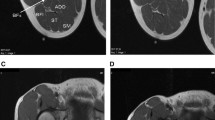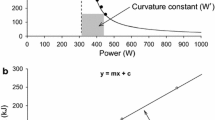Summary
The contractile characteristics of the sartorius muscle isolated from the frog,Rana pipiens, and the toad,Bufo americanus, are compared at 25°C and pH 8.0. Frog sartorius muscles have faster shortening velocities and greater mechanical power at low loads, while toad sartorius muscles develop greater tetanic tension (Fig. 1). During the rising phase of an isometric tetanus, the latent period and time to half-maximum tension are shorter and the rate of tension development is faster in frog sartorius muscles than in toad sartorius muscles (Table 1). There is no difference between the two species during relaxation, i.e., the half-relaxation time after an isometric tetanus is quite similar (Table 1). It is concluded that most of the contractile characteristics of frog and toad sartorius muscles correlate well with the habits, jumping ability, burrowing activities and endurance to fatigue of the two species in the field.
Similar content being viewed by others
References
Barany M (1967) ATPase activity of myosin correlated with speed of muscle shortening. In: The contractile process, Proceedings of a symposium, New York Heart Association. Little, Brown and Company, Boston, pp 197–218
Brattstrom BH (1963) Preliminary review of the thermal requirements of amphibians. Ecology 44:238–255
Calow LJ, Alexander R McN (1973) A mechanical analysis of a hind leg of a frog (Rana temporaria). J Zool (Lond) 171:243–321
Close R (1965) The relation between intrinsic speed of shortening and duration of the active state of muscle. J Physiol (Lond) 180:542–559
Crow MT, Kushmerick MJ (1982) Chemical energetics of slow-and fast-twitch muscles of the mouse. J Gen Physiol 79:147–166
Dickerson MC (1906) The frog book. Dover Publication Inc, New York
Emerson SB (1978) Allometry and jumping in frogs: helping the twain to meet. Evolution 32:551–564
Gibbs CL, Chapman JB (1974) Effects of stimulus conditions, temperature and length on energy output of frog and toad sartorius. Am J Physiol 227:964–971
Hill AV (1938) The heat of shortening and the dynamic constants of muscle. Proc R Soc Lond 126B:136–195
Hill AV (1950) The dimensions of animals and their muscular dynamics. Sci Prog 130:209–230
Huxley AF (1957) Muscle structure and theory of contraction. Prog Biophys Biophys Chem 7:255–318
Jewell BR, Wilkie DR (1958) An analysis of the mechanical components in frog's striated muscle. J Physiol (Lond) 143:515–540
Josephson RK (1975) Extensive and intensive factors determining the performance of striated muscle. J Exp Zool 194:135–154
Prosser CL (1973) Comparative animal physiology. Saunders, Toronto
Putman RW, Bennett AF (1981) Thermal dependence of behavioral performance of anuran amphibians. Anim Behav 29:502–509
Reeves RB (1969) Role of body temperature in determining the acid-base state in vertebrates. Fed Proc 28:1204–1208
Renaud JM (1981) Temperature adaptation of sartorius muscle in the frog,Rana pipiens, and in the toad,Bufo americanus. Ph D thesis, University of Guelph, Guelph, Ontario
Renaud JM, Stevens ED (1981) Effect of acclimation temperature and pH on contraction of frog sartorius muscle. Am J Physiol 240:R301-R309
Ritchie JM, Wilkie DR (1955) The effect of previous stimulation on the active state of muscle. J Physiol (Lond) 130:488–496
Sandow A, Zeman RJ (1979) Tetanus relaxation. Temperature effects and Arrhenius analysis. Biochim Biophys Acta 547:27–35
Zug GR (1972) Anuran locomotion: structure and function. I. Preliminary observations on relation between jumping and osteometrics of appendicular and postaxial skeleton. Copeia 1972:613–624
Zug GR (1978) Anuran locomotion: structure and function. II. Jumping performance of semiaquatic, terrestrial and arboreal frogs. Smithson Contrib Zool 276:1–31
Author information
Authors and Affiliations
Rights and permissions
About this article
Cite this article
Renaud, J.M., Stevens, E.D. A comparison between field habits and contractile performance of frog and toad sartorius muscle. J Comp Physiol B 151, 127–131 (1983). https://doi.org/10.1007/BF00689910
Accepted:
Issue Date:
DOI: https://doi.org/10.1007/BF00689910




